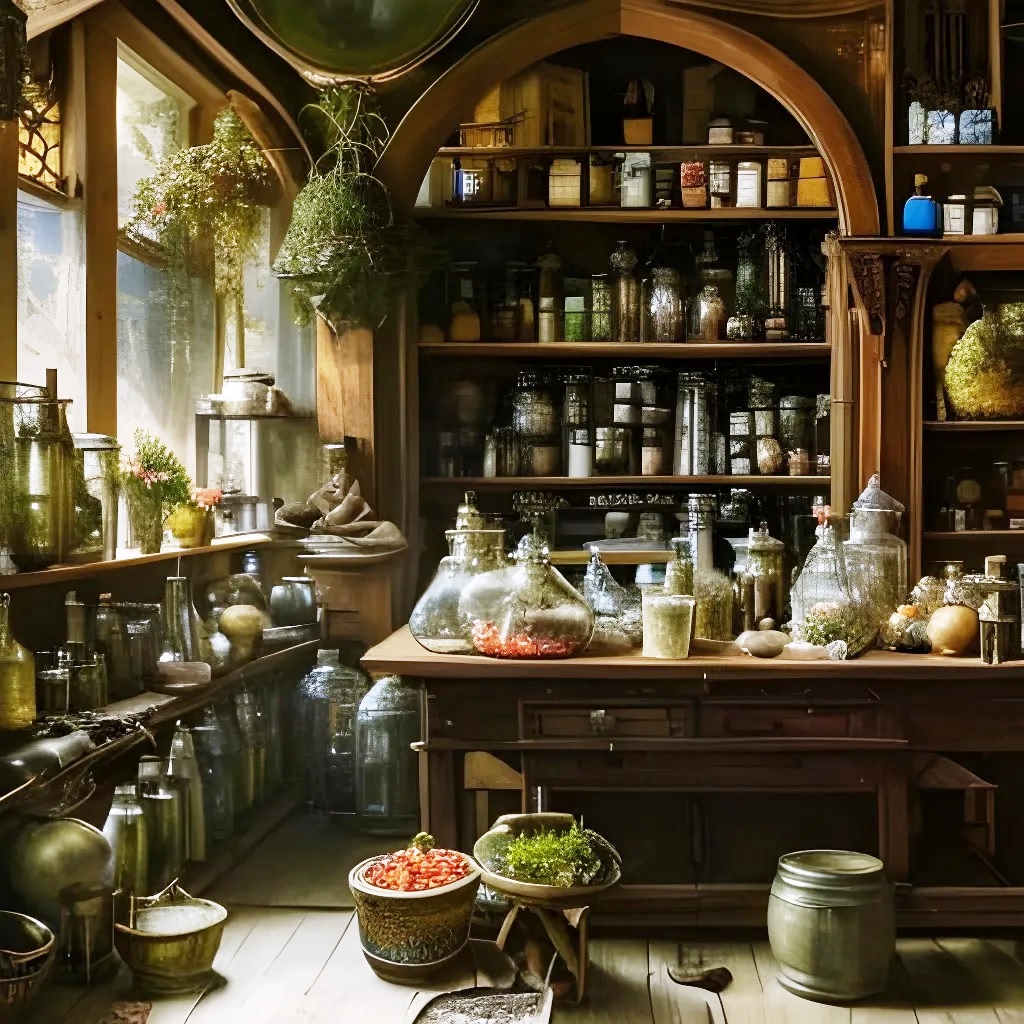Apothecary
Apothecary shops were essential establishments that play an important part of the time period's medical care. Often nestled in the heart of bustling medieval towns, their rustic facades adorned with wooden signs bearing symbolic images and Latin inscriptions that hint at their medicinal offerings and plants. Professions associated with these shops include physicians, herbalists and even clerics — and in a less savoury light, assassins as well.
As evidence of their apparent wealth, a typical shop is a timber-framed structure, its beams adorned with intricate carvings and decorative ironwork. Buildings occur in affluent districts and are likely two or three stories high, and the shop's main entrance is flanked by large, leaded glass windows adorned with ornate wrought iron bars, allowing the warm, golden glow of candlelight to spill onto the cobblestone street outside. The traditional figure on the shop's sign is a serpent intertwined with a staff, a symbol often associated with healing in the 16th century. European shops offer a Latin inscription that proudly proclaim, "Apotheca Medicamentorum."
Atmosphere
Upon entering the apothecary shop, one is enveloped in a rich tapestry of scents - the earthy aroma of dried herbs, the pungent fragrance of spices, and the sweet perfume of floral extracts. The shop is a cozy, dimly lit space, its wooden shelves and counters lined with an array of glass jars, wooden boxes, and ceramic pots containing ingredients and remedies. The atmosphere in the apothecary shop is one of quiet reverence and curiosity, with the flickering candlelight casting dancing shadows on the aged wooden beams. The apothecary moves with deliberate grace, measuring out ingredients, grinding herbs, and offering counsel to the afflicted. The gentle rustling of parchment and the soft clinking of glass vials provide a soothing backdrop to the ancient art of healing practiced within these walls.
The shop is not only a place of commerce, but a haven of knowledge, tradition and hope, where the mysteries of nature and the art of healing intertwine to serve the health and well-being of many important persons. Apothecaries possess a broad knowledge spanning various subjects and have a wide network of acquaintances. Consequently, they frequently encounter inquiries that necessitate a brief waiting period as the apothecary consults both literary references and personal connections to provide accurate answers.
Herbs & Botanicals
The heart of the apothecary shop lies in its extensive collection of herbs and botanicals. Dried herbs hang from the ceiling in bundles, and colorful flowers, roots, and leaves are neatly arranged in wooden drawers and glass jars. Herbs like chamomile, lavender, and rosemary are prized for their healing properties, while exotic spices such as cinnamon, cloves, and cardamom are displayed alongside them, used not only for flavor but also for medicinal purposes.
Pharmaceutical Equipment
The apothecary possesses an assortment of peculiar instruments, from mortars and pestles for grinding herbs to alembics and retorts for distillation and extraction. These tools are meticulously arranged on shelves and in cabinets, each piece bearing the marks of age and use. They are essential for preparing tinctures, elixirs, and remedies.
Customers
Apothecaries value tranquility, as it greatly aids their studies and practice, given that their work demands a high degree of concentration and careful consideration. It's not unusual to discover that the apothecary's shop remains closed for an hour or even longer, or is temporarily overseen by an apprentice when the apothecary is unavailable.
Nonetheless, customers from all walks of life — but more commonly the wealthy — visit, seeking relief from various maladies. Gentry, commoners and foreign travellers poke about the shop's wares and consult with the apothecary or whichever apprentice is available. Some come with their own containers, hoping to purchase remedies in bulk. Rustics sometimes wander in to provide collected herbs in exchange for a few coins.
Apothecaries also participate in intellectual discussions and share their findings, contributing to the advancement of medical knowledge. This collaborative spirit fosters a sense of community and mutual support among practitioners of the healing arts.
See also,
Equipment Notes
Healing Salve (remedy)
